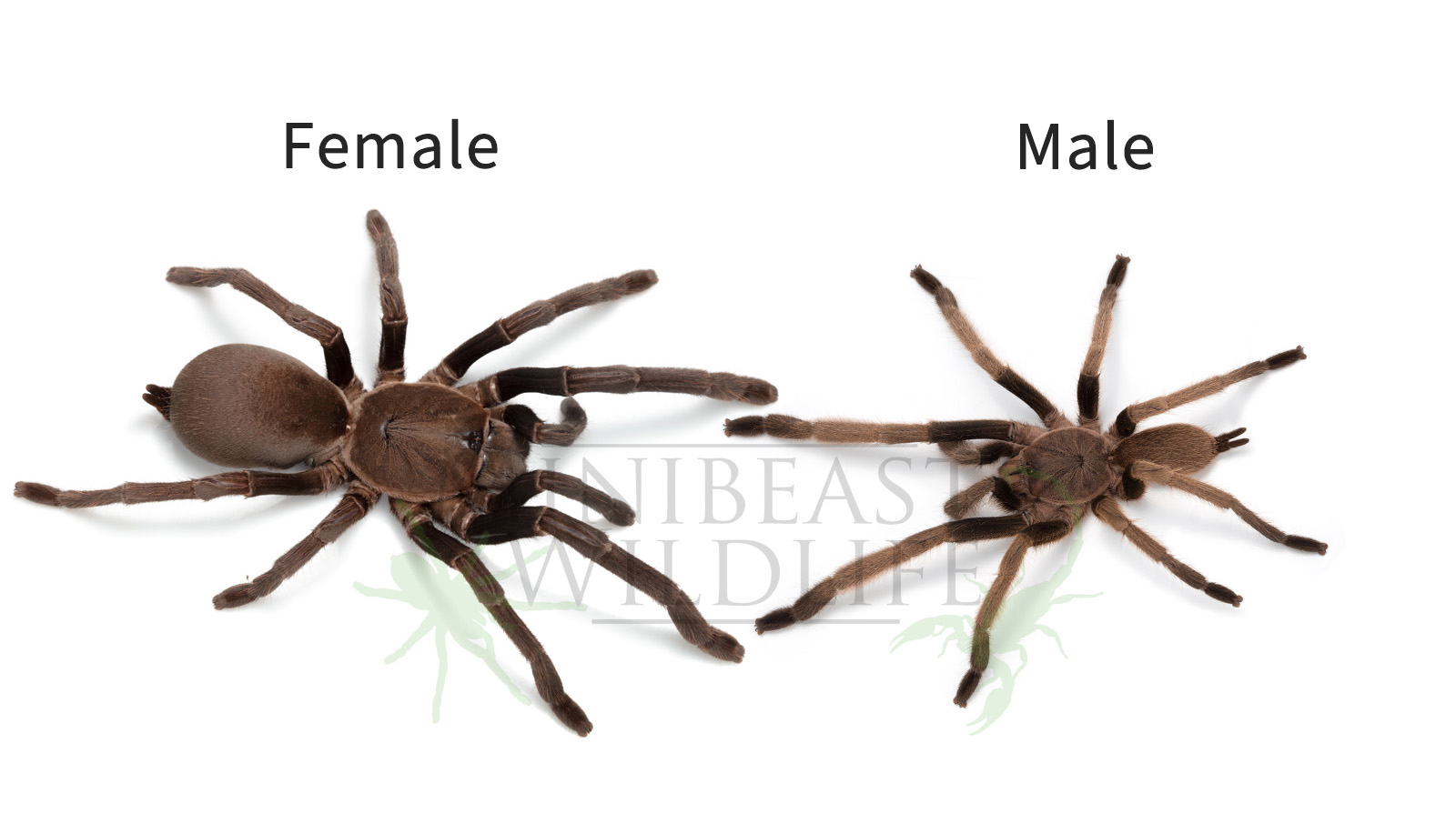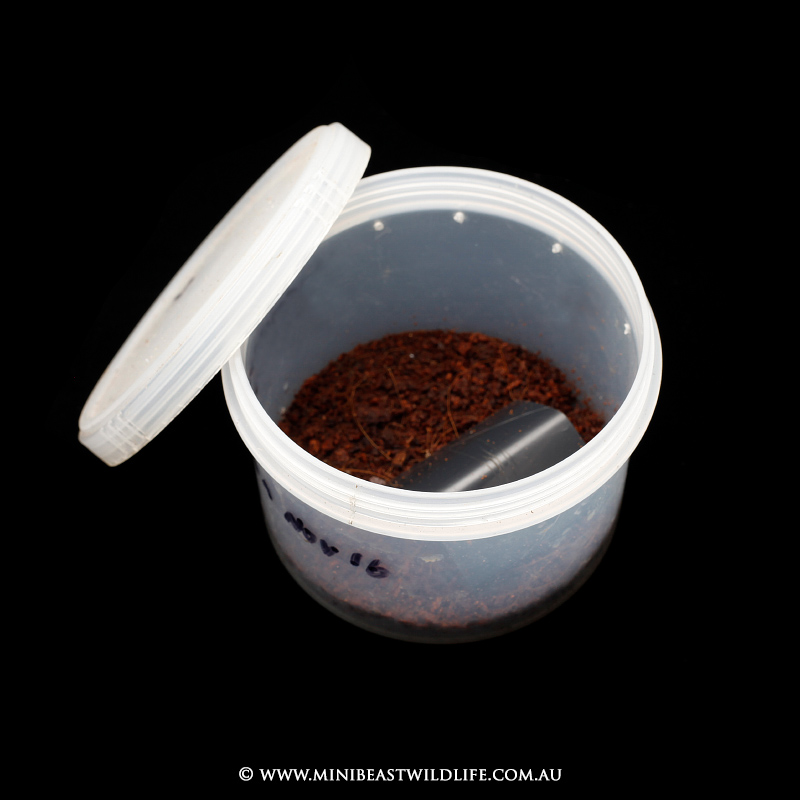
How to tell the sex of Australian tarantulas
Is your tarantula a male or female? How can you tell? In this article we’ll show you how to sex your tarantula!
Here we conclude our four part series on getting your first pet Australian tarantula. If you haven’t already, make sure you catch up the previous blogs in this series, breaking down permits and regulations, types of tarantulas and what to keep in mind when you’re ready to buy. If you’re up to date on your spider blogging, then let’s get ready for our final topic – keeping your new pet healthy, happy and thriving.


Last post we discussed the best age to buy your new eight-legged companion. Remember, just like learning any new skill, it’s completely normal to make a few mistakes as a first time keeper. While tarantulas aren’t particularly tricky to look after, there are a couple of common pitfalls that could result in the death of your new pet. Starting with a sling of around 3rd – 4th instar (defined in Part Two) means that you get to experience the growth of your spider and learn about how tarantulas behave from the beginning all the way through to adult tarantula – but which one? At this point, you’ll find out very quickly that Australian tarantula “species” are a swamp of bizarre names and numbers, of which no official or complete list exists (we’ll get to why). To break it down, there are probably around eight different groups (genera) of tarantulas in Australia, with four most commonly kept as pets. There’s no “best” tarantula to keep, but they do all have differences in appearance, behaviour and growth rate which you will need to be aware of before purchasing.
First, you’ll need a suitable enclosure. If you talk to experienced tarantula keepers, you’ll quickly find that each of them swears by a different style, size and brand of enclosure as the best way to keep a pet tarantula. Keep in mind when you receive conflicting advice that there is no one right way to do things, and simple set-ups can be just as effective as the more complex ones. When it comes to the right enclosure, what’s important is not whether you choose glass or plastic, ventilation or no ventilation, big enclosure or small – it’s that you know what your tarantula needs, and that you find some way to provide it.

A simple example of a good enclosure set-up for a sling is a small plastic container or terrarium, with the bottom third filled with coir-peat (coco-peat) as a substrate. (Available pre-mixed from our Bug Shop and in dry form from garden supply stores). Having at least some holes for ventilation is a good idea if you’re just starting out – though some keepers swear by ventilation, others forgo it almost entirely. You can provide the tarantula with a small hide, such as a curved piece of bark or a plastic one (cut-up pieces of cheap plastic plant pots work well). As your tarantula grows, you will need to upgrade the size of your enclosure using options such as terrariums, larger plastic containers or even glass display tanks. The choice is yours!


Substrate – the “dirt” mix you provide for the tarantula to live in – can be one of the trickier things to get right when you start off. You may see others recommending mixes with sands or other substrates such as sphagnum moss, but at this stage it is perfectly fine to keep it simple and use coir-peat only. Your tarantula won’t miss out on anything, and it means you can get used to how this spider keeper’s staple looks and feels.

Getting the substrate moisture right takes practice, but it’s one of the most essential ingredients of successful tarantula keeping. One tactic you can use to make sure you have it right is using a moisture gradient. Provided there is room, you can keep one side of the enclosure a little more moist, trailing off to the other side which is a little drier. Neither end of the gradient should reach the extremes of wet or dry pictured above.
If your enclosure is too small for a gradient, such as a container for a sling, then try to aim for the photo in the middle. If you pick up the substrate and it crumbles to pieces, it’s too dry. If you squeeze it and water comes out, it’s too wet. Compact the substrate enough that it holds most of its shape when you dig into it, ensuring that your tarantula is able to happily burrow. Substrate moisture is one of the most important things to keep an eye on, because it can dry out quickly when you have more ventilation – especially if you have air conditioning or heating in the house – and if you have less ventilation you may be greeted with mould.
Found mould? It’s not as big a deal as you might fear. It’s natural for this fungal growth to turn up in tarantula enclosures, which are the exact conditions mould needs to thrive. Small amounts of these common fungal growths (and there are many) do not harm tarantulas. They can indicate that there are food left-overs in the enclosure that need to be removed, but also can arrive on apparently “clean” items such as bark. Small pockets of growth can be scooped out using a spoon. If the growth appears to spreading, you may choose to change the entire substrate and wash out the enclosure. Keep in mind that if you reintroduce items from your former set-up, the mould might come back with them!
In the wild, tarantulas feed mainly on live invertebrates – such as insects – but will take small vertebrates when the chance arises. In captivity, the easiest way to feed your tarantula is to buy live crickets from your local pet shop.
Avoid using live cockroaches, as they will burrow into the soil and hide, leading to problems later. Tarantulas can eat on vastly different schedules depending on their age and proximity to a moult, but you can offer them crickets once per week if you are unsure, or twice for hungry growing tarantulas, removing live food afterwards if the tarantula is not interested. It is not unusual for a tarantula to take food each day for a few days in a row if it’s growing, or to refuse food for a month, especially as an adult. Get to know the size of your spider’s abdomen and use it as a guide – if it’s very plump and isn’t eating, don’t worry. If the abdomen is thin or small in appearance, it’s a very hungry tarantula and needs to feed.

It’s important that any live insects are removed from the enclosure if the tarantula doesn’t appear interested in eating them. If your spider moults while insects are present, they are able to chew on and kill it. For this reason, many keepers have taken to feeding freshly killed insects instead (freezing is the best method). Your spider will happily eat dead food, and the only consideration you will need to keep in mind is removing uneaten insects before mould grows. All you need to do is leave the insect in the enclosure near the spider’s burrow or hide, and your wily arachnid will find it with ease.
Many people are horrified to check on their pet tarantula, only to find it upside down on the substrate and apparently dead. This is actually a perfectly normal part of the moulting process, where the tarantula turns onto its back in preparation to pump its way out of its old exoskeleton and grow larger. The time this process takes can vary massively, but once it starts, there’s nothing you can do to help it along. Before the exoskeleton pops open and the actual process of squeezing out begins, your tarantula may lie still for several hours, twitching the limbs periodically. Once moulting properly begins, it could take anywhere from an hour for a small spider, to much longer for a large one. The legs will not be curled on themselves in during this time, which is the sign of a dying or dead tarantula.
At the end of this ordeal, your tarantula will be larger, differently coloured, and will be unlikely to take food for several days. You’ll also be left with a cool tarantula exoskeleton, which looks just like an empty spider. During this time, tarantulas are very soft and vulnerable, which is why it’s important that all live insects are removed.
First-time keepers often worry quite a bit about getting the temperature right in the tarantula enclosure. Keeping in the moderate range between 22 – 26°C is recommended, and especially important is staying away from sustained extremes at either end. Heating or cooling can dry out substrate quickly in ventilated enclosures, so keep that in mind. At the end of the day, seasonal fluctuations are natural and as long as they don’t dip too low or too high, your tarantula will thrive.
While there’s a lot that goes into tarantula keeping, these basics will get you started. For further information, see our free care guide, or you can order Bugs Alive! a guide to keeping Australian invertebrates. You can also chat to other keepers, who have plenty of information to share – Facebook groups such as Australian Spiders in Captivity are good places to start meeting other tarantula hobbyists and ask questions, or contact us.
Article written by
Do you like this article? Share it on your favourite platform.

Is your tarantula a male or female? How can you tell? In this article we’ll show you how to sex your tarantula!

The truth about Australia’s most deadly bugs that bite and sting

Minibeast Wildlife is engaging students throughout the Wet Tropics, visiting schools in Cairns, the Northern Beaches and the Tablelands.

It’s often tempting to buy the biggest most impressive specimens, but if those animals have been taken straight from the wild, there are issues you should be aware of.